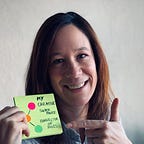Who Should Lead Design Thinking in HR?
“In your experience have you seen any success stories that came from outsiders or experts in design from the business pushing in to tackle the people practice problems vs HR professionals applying the techniques of design? I wonder if in addition to leadership buy-in, one solution is getting outsiders to take on more of a lead with organizational issues that seem like they belong in HR, but really require broader thinking and scope. I feel like this happens in larger organizations often providing stretch/growth opportunities for people, but not as much in smaller organizations,”
wonders newsletter reader Keli.
As I started to reflect on Keli’s question, I realized how biased I am in my own conviction that HR should build design thinking skills and capability to enhance the employee experience and refocus the function on the “human” factor. A good reminder how important reflection is…
So, I sat down and brainstormed pros and cons for both, HR leading design thinking in the people space, and designers leading the work. Here is where I landed:
HR Leading Design Thinking
Pros
· As part of the design thinking process, employees might share confidential information with an HR designer. The same is true for the analysis of project relevant people data which cannot be accessed by or shared with designers outside of HR.
· When conducting research interviews with employees, some questions might trigger past trauma. You need to have an interviewer who is equipped to navigate these conversations with care.
· HR can drive large scale change when it comes to implementing solutions related to the employee experience.
Cons
· HR lacks confidence in the design thinking method. It is still an emerging practice in our field.
· Design thinking requires a fundamental mindset shift in Human Resources (“HR being so deeply rooted in doing what’s safe, predictable and least risky, it just makes the use of Design Thinking so much harder,” as Keli points out)
· Some designers question the use of design thinking by non-designers [see Natasha Jen’s critique as an example].
What resonates? What doesn’t? What did I miss?
Designers Leading Design Thinking
Pros
The points that Keli made in her comments resonate with me here:
· Leadership buy-in: If someone from the business leads the charge, there might be better or quicker buy-in from leaders. I am a huge advocate for partnering with business units or functions who have already applied design thinking to their business practices and then explore how they might get applied in the people space.
· Broader, outside-in perspective: It’s always a good idea to get fresh eyes on our legacy people programs, processes, and policies.
· Can provide stretch/growth opportunities for employees: Love this! I am a fan of providing our employees with job enrichment opportunities where they can practice leadership skills. I consider critical thinking, empathy, problem exploration, and co-creation to be key leadership competencies in today’s environment.
Cons
· Designers tend to be solely focused on solving user pain points. This focus might lack systems view and/or can be misaligned to business outcomes.
· Employees are not customers or users; they are co-workers and require a different level of care. This is a point that was so beautifully made by Lee Kim during our recent Talent Tales interview.
· Designers might lack an understanding of how to adjust design thinking methods to an HR and internal audience.
What resonates? What doesn’t? What did I miss?
MY CONCLUSION
In an ideal world, I would have a designer and an HR professional co-lead the project to benefit from both perspectives and complimentary expertise. This is how I discovered design thinking six years ago. During an HR related client project, I was introduced to their Innovation Lab, and we ended up co-creating the experience. That’s when I decided to become a student of the framework and to explore its potential for our function.
I am so curious: What do you, my dear newsletter subscribers, think? What are success stories for either scenario that you can share?
Note: This article was originally published as part of the Design Thinking for HR LinkedIn Newsletter.
ABOUT THE AUTHOR
The Design Thinking for HR newsletter is a biweekly LinkedIn newsletter designed to inspire HR professionals to experiment with the design thinking framework. The newsletter is curated by Nicole Dessain who is an employee experience consultant, design thinking workshop facilitator, and Northwestern University instructor. Nicole is the host of the Talent Tales podcast, where she interviews leaders who have pioneered design thinking in Human Resources.
